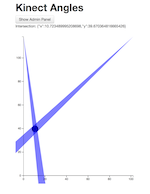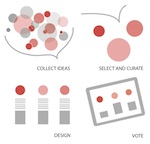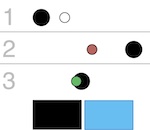Working and living internationally can be a rewarding but difficult experience. This project investigates how people gain intercultural competence while developing technology to support the learning experience. We are currently developing a system to help new international teaching assistants allow for increased and equitable discussion in the recitation sections they lead. For many ITAs, discussion has not been a part of their previous school experience. Our personal informatics-based system detects and visualizes classroom talk, allowing the TAs to see how much teaching time they devote to student participation and the distribution or domination of students in class discussion, and to develop goals for increasing effective discussion in their classes.
This work led to my dissertation. My thesis moves beyond looking only at international teaching assistants and works with a much broader sample of TAs working in higher ed.
This was a service design project for the Pittsburgh Symphony Orchestra that I did with fellow student collaborators at CMU's School of Design. The PSO was hoping to find a way that they could encourage occasional symphony visitors into the fold of regular subscribers. While this was a reasonable and valuable goal, our team made a different proposal. We pivoted toward a new goal of trying to make the symphony attractive to people who had never shown interest in orchestral music. Our 5 Minute Experiment was an open call to community musicians to imagine how they might use a world-class symphony to create a completely new and original musical experience — but only 5 minutes long. These performances would then be part of an "opening act" for pops concerts where more traditional symphony fans could experience new artists and new artists could find their way into a new community of music lovers.
This study revisited some of the mid-nineties research into the social nature of computers coming out of Stanford at that time. I re-created a research design whereby a computer would help the study participant on some task, and then ask for help in return on a task that the computer was trying to accomplish. What I did differently in this study was to include a personality assessment to see if we could find any correlations between the number of favors people perform for a generous computer and the reciprocal orientation of the person. In an interesting twist, we ended up not being able to replicate the original results where people on average performed more favors for a helpful computer than they did for a non-helpful computer. What we found, however, was a surprise in that people who ranked low in "agreeableness" did significantly more favors for the computer than the people who ranked high in agreeableness. This ran counter to our hypotheses, and so we ran a second study where we replaced the computer with a human being. In that case it turned out that "agreeable" people did more favors for a helpful human. So as it turns out, maybe people don't treat computers the same way they treat humans, but they still don't seem to treat them as tools. There is a lot more to be investigated here!
This is definitely the most cognitive research I've ever done. It was a treat to have the guidance of Frank Drews in developing a new method for investigating executive function where we could manipulate attentional activation of a human participant at the bit level. While the method is a bit technical to describe (you can read it in the paper), the short of it is that we used a call and response arithmetic game between study participant and researcher where we would change between 0 and 4 bits of information processing in terms of task switching requirements between trials. While doing this the participant was also moving a joystick to match a randomly swinging circle on a computer screen. They also had to push a button when their cursor turned red and not push the button when their cursor turned green. It was really hard!
We hypothesized that we would see a linear decrease in performance as the complexity of the task increased, but what we found was more interesting (and not surprising in retrospect). It turns out that while the task difficulty increases, people perform better (in terms of tracking the circle and pushing the button quickly). Until you get to the 3 to 4 bit level of difficulty, at which point performance crashes. Now, the interesting thing about this method is that we have a real world task that we could theoretically reverse engineer to determine the complexity of executive function based on some manual task, such as driving.




